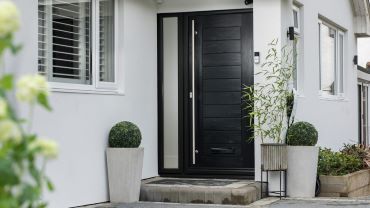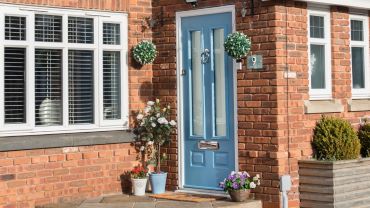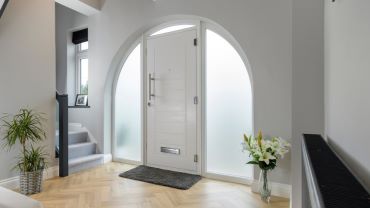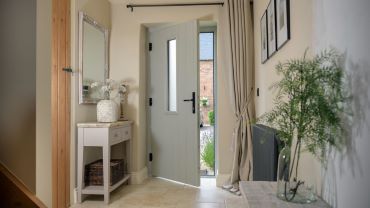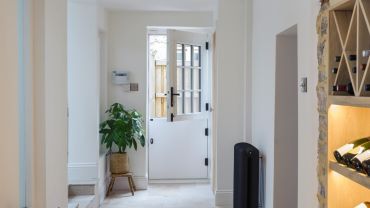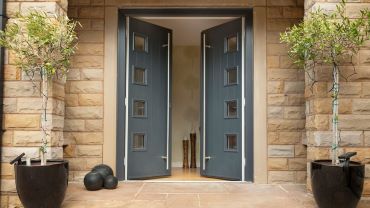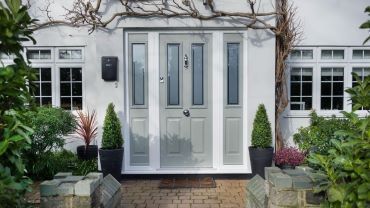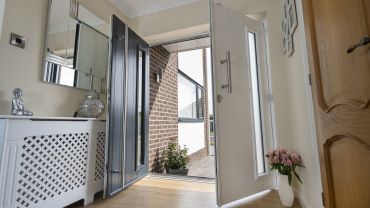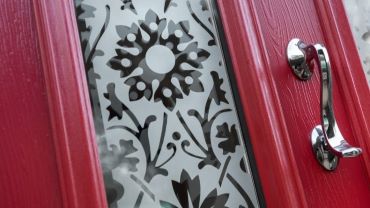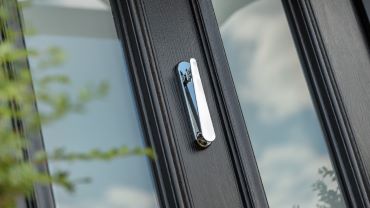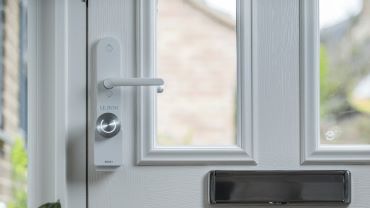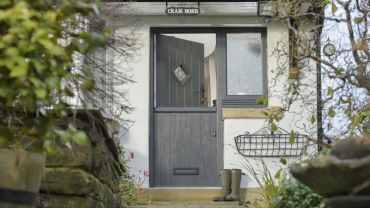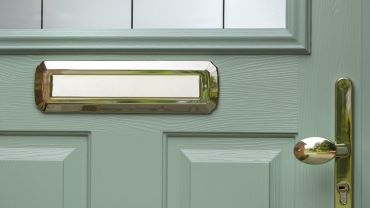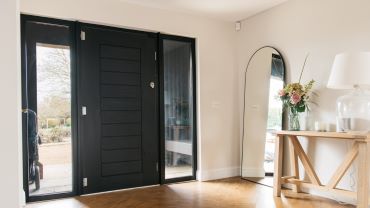Introduction
Choosing a new front door is a big decision. It’s the first thing people see when they visit your home, and it plays a key role in your property’s security, energy efficiency, and overall style. But with so many options out there, it’s easy to feel overwhelmed, especially when it comes to materials.
Two of the most popular choices are composite doors and uPVC doors.
Both have their strengths, but they’re built differently and offer different benefits. This guide will walk you through everything you need to know, from how they’re made, to how they perform, so you can make the right choice for your home.
Not sure which door is right for your home? This guide compares composite and uPVC doors across the things that matter most:
What is a composite door?
A composite door is built using a combination of materials. Typically these are constructed with either a solid timber core or insulating foam, which is then encased in a reinforced plastic skin such as GRP (Glass Reinforced Plastic). This layered construction gives the door its strength, durability, and excellent thermal performance.
Jargon buster: The “skin” of a door is the outer layer that provides both protection and visual appeal.
Solidor’s composite doors are constructed to a high specification. Each door features a 48mm thick solid timber core, encased in a tough ABS (Acrylonitrile Butadiene Styrene) skin; this is the same material used to make LEGO® bricks, which are also known for their incredible durability and resistance to colour fade.
Did you know? Unlike foam-filled composite doors, Solidor’s solid timber core offers superior resistance to bowing and impact, making it one of the most secure options on the market.
Why it matters: Composite doors are designed to look like traditional solid wood doors, but with modern benefits like low maintenance, high security, and improved energy efficiency. They’re ideal for homeowners who want style without compromise, and that is built to last.
What is a uPVC door?
A uPVC door (short for unplasticised polyvinyl chloride) is made from a rigid, weather-resistant plastic and it’s a popular choice for homeowners due to their affordability and low maintenance.
Unlike older models, today’s uPVC doors often feature steel reinforcements that improve strength and insulation. While they may not match the premium feel of composite doors, they still offer solid performance for everyday use.
Did you know? Many uPVC doors now come with multi-point locking systems and decorative glass options, making them more versatile than ever.
Why it matters: uPVC doors are a budget-friendly solution that provide decent insulation, basic security, and a clean, modern look. They’re ideal for homeowners who want a functional door on a budget.
Advantages and disadvantages
When choosing between a composite and a uPVC door, it’s important to weigh up the pros and cons of each. Both materials offer unique benefits, but they also come with trade-offs.
Here’s are some advantages and disadvantages of each type of door.
Advantages of a composite door
Composite doors are often seen as the premium choice and for good reason. They combine multiple materials to deliver strength, style, and performance.
- Strength & security: Solid core construction makes it highly resistant to forced entry
- Thermal efficiency: Excellent insulation helps keep your home warm and energy bills down
- Design flexibility: Wide range of colours, finishes, and glazing options
- Longevity: Built to last 20–30 years with minimal upkeep
Disadvantages of a composite door
While composite doors offer plenty of benefits, they’re not without their drawbacks.
Here are a few things to consider before making your decision.
- Cost: Typically more expensive than uPVC
- Weight: Heavier, which may require stronger hinges and installation expertise
Advantages of a uPVC door
uPVC doors are a popular choice for homeowners looking for a simple, cost-effective solution. They’re easy to maintain and do the job well in many situations.
- Affordability: One of the most cost-effective door options
- Low maintenance: Doesn’t need painting or sealing
- Weather resistance: Good resistance to moisture and rot
Disadvantages of a uPVC door
Despite their affordability, uPVC doors do have limitations, especially when it comes to durability and design.
- Limited design options: Fewer colours and styles available
- Lower durability: Can warp or discolour over time
- Less secure: Not as strong as composite doors, though security can be improved with upgrades
Design and style options
Your front door isn’t just a way in, it’s your statement. It reflects your personality, complements your home, and sets the tone for what’s inside. Whether you’re going for bold and modern or classic and understated, the right design can elevate your home’s kerb appeal and make a lasting impression.
Both composite and uPVC doors offer design choices, but the level of customisation varies significantly.
Composite door design options and styles
Composite doors are known for their versatility and premium finish. You can choose from a wide range of:
- Colours: From timeless whites and greys to bold blues and greens
- Finishes: Woodgrain textures, smooth skins, and high-definition detailing
- Glazing styles: Decorative, frosted, clear, or patterned glass
- Hardware: Handles, knockers, letterplates, and hinges in various finishes
- Layouts: Traditional panels, contemporary flush designs, or cottage styles
Jargon buster: “Furniture” refers to the handles, knockers, and letterplates that complete the look of your door.
Door styles
Traditional
Traditional composite doors often feature classic panel designs, muted colours and heritage-inspired glazing. They’re ideal for period homes or creating that ‘timeless’ feel.
Traditional style composite doors balance the enduring charisma of classic design with the performance of modern engineering.
Expect to pay a little extra for authentic period details though.
Contemporary
Contemporary composite doors are the go-to for more modern styles and avant-garde architecture.
Clean lines, bold colours and minimalist hardware go well with this style.
Premium finishes or unique designs may add to the cost but are worth it if you’re looking to make a striking first impression.
uPVC door design options and styles
uPVC doors offer simpler styling and fewer customisation options. They’re typically available in:
- A limited range of colours (often white, grey, or wood-effect)
- Basic panel layouts
- Standard glazing options
While they’re ideal for utility areas, rental properties, or budget-conscious projects, they may not offer the same level of personalisation or visual impact as composite doors.
Security options and features
Your front door is your home’s first line of defence, and security should never be an afterthought. Whether you’re protecting your family, your belongings, or simply seeking peace of mind, choosing a door with robust security features is essential.
While both composite and uPVC doors offer protection, composite doors generally come out ahead thanks to their construction and advanced locking systems.
How secure is a composite door?
Composite doors are built with security at their core, quite literally. Stronger composite doors, like Solidor’s, feature a 48mm solid timber core, encased in a tough ABS skin, making them highly resistant to impact and forced entry.
They’re fitted with multi-point locking systems, 3-star rated cylinders, and are tested to meet PAS 24 and Secured by Design standards. This is the UK Police initiative for crime prevention.
Jargon buster: PAS 24 is a UK standard that tests doors against forced entry using tools like crowbars and chisels.
These features aren’t just technical specs, they translate into real-world protection and come as standard. Homes with Secured by Design doors are 75% less likely to be burgled. A solid timber core construction ensures your door won’t just resist tampering, it will actively deter it.
Traditional handles
When considering security options for an exterior entrance door, traditional locks can be a reliable and cost-effective solution. There are ways to enhance a traditional lock for better front door security. For example a deadbolt can add an extra layer of security, without adding drastically to the cost.
Multi-point locks
Although traditional locks are generally a solid option, they can be vulnerable to lock picking and physical attacks. This is where multi-point locking can have significant advantages. The multiple locking points along the frame make them far harder to force and the extra complexity of their internal mechanisms makes them harder to pick. On top of this, most modern multi-point locks come with additional features, such as ‘double sacrificial snap protection’, which prevents anyone from snapping the lock, a common technique in break-ins.
Smart locks
Smart locks combine smart technology with convenience and peace of mind. They work remotely, can be opened hands free with keyless technology and can even be set to lock automatically when you leave the house.
The best door locks are now compatible with smart door locking, so you don’t have to sacrifice security in favour of convenience.
How secure is a uPVC door?
uPVC doors offer basic security, typically with multi-point locks and reinforced panels. They’re suitable for most homes, especially when fitted with upgraded cylinders and security accessories.
However, their lighter construction and single-material build make them more vulnerable to impact and manipulation. While they can be enhanced with better locks, they may not match the structural integrity of a composite door.
Energy efficiency
A well-insulated door doesn’t just keep your home warm in winter and cool in summer. It can also help reduce your energy bills and carbon footprint.
When comparing composite and uPVC doors, thermal performance is a key factor that affects comfort, cost, and sustainability.
How warm is a composite door?
Composite doors are engineered for exceptional thermal efficiency. Solidor’s doors feature a 48mm solid timber core, layered with insulating materials and encased in a durable ABS skin. This construction helps trap warm air inside and block cold air from entering. This keeps your home comfortable all year round.
Jargon buster: U-value measures how well a door insulates. The lower the U-value, the better the insulation. Solidor composite doors typically achieve U-values as low as 1.4 W/m²K, meeting and exceeding UK building regulations.
But it’s not just about materials, it’s about how the door is built and installed. Our doors are designed with tight compression seals, reinforced frames, and high-performance glazing options (including triple glazing options) to minimise heat loss and eliminate draughts.
How warm is a uPVC door?
uPVC doors offer decent insulation, especially when fitted with multi-chamber profiles and double glazing. They’re suitable for everyday use and can help reduce heat loss, but they typically have higher U-values than composite doors, meaning they’re not quite as effective at retaining warmth.
Over time, uPVC doors may also suffer from seal degradation, which can lead to draughts and reduced thermal performance. While they’re a budget-friendly option, they may not deliver the same long-term energy savings as a well-constructed composite door.
Environmental impact and sustainability
More homeowners are thinking about the environmental impact of their choices, and doors are no exception. From the materials used to how long they last, your front door can play a role in reducing your carbon footprint and supporting a more sustainable future.
How sustainable is a composite door?
Composite doors are designed to last decades, which means fewer replacements, less waste, and a lower environmental impact over time. Our doors feature a solid timber core sourced from sustainably managed forests, and the ABS skin is fully recyclable.
Jargon buster: FSC-certified timber means the wood is sourced responsibly, with every tree harvested replaced by new planting.
Unlike foam-filled alternatives, a solid-core design avoids the use of non-recyclable materials and offers better long-term performance. The durability of the door also means fewer repairs and replacements, which in turn reduces landfill waste and resource consumption.
Did you know? Solidor also works with eco-conscious suppliers, uses fuel-efficient delivery methods, and is committed to minimising production waste. Choosing a composite door from Solidor isn’t just a style decision, it’s a sustainable one.
How sustainable is a uPVC door?
uPVC doors are recyclable, but their shorter lifespan and susceptibility to discolouration mean they may need replacing more frequently. Over time, this can lead to more waste and higher environmental costs.
While some manufacturers use recycled uPVC, the material itself is less durable and can degrade under UV exposure. This means more frequent replacements and a greater overall carbon footprint compared to a long-lasting composite alternative.
Lifespan and durability
A front door is more than just a purchase, it’s an investment in your home’s comfort, security, and kerb appeal.
Understanding how long your door will last helps you make a smarter, more sustainable choice.
How long will a composite door last?
Composite doors are built to stand the test of time. Thanks to their multi-layered construction, solid timber core, and weather-resistant skin, they can last 30 years or more with minimal maintenance.
High quality composite doors, like Solidor, are engineered to resist warping, rotting, and fading even in harsh weather conditions. Features like moisture barrier systems and reinforced frames help maintain structural integrity over decades of use.
Jargon buster: A moisture barrier system prevents water ingress, which can cause swelling, warping, and internal damage.
Routine care, like cleaning with mild detergent and lubricating hinges, can add years to your door’s life.
How long will a uPVC door last?
uPVC doors typically last 15–25 years, depending on the quality of the materials and how well they’re maintained. They’re resistant to rot and moisture, but can be prone to discolouration, warping, and seal degradation over time, especially in areas exposed to strong sunlight or temperature fluctuations.
While uPVC doors are a cost-effective option, they may need replacing sooner than composite doors, which can increase long-term costs and environmental impact.
Price and long-term value
Budget is often a deciding factor when choosing a new front door, but it’s important to look beyond the initial cost.
A door is a long-term investment in your home’s security, energy efficiency, and kerb appeal.
Here’s how composite and uPVC doors compare when it comes to price and value.
How much does a composite door cost?
Composite doors are a premium product, with prices typically starting from around £1,000 and increasing based on design and features, sometimes up to around £3,000. The more expensive end of the scale usually includes, bespoke designs with premium glazing, hardware, and side panels.
What you’re paying for:
- A solid timber core for strength and insulation
- High-security locking systems
- Custom colours, woodgrain finishes, and decorative glazing
- Long lifespan (20–30+ years) with minimal maintenance
While the upfront cost is higher, composite doors offer better long-term value thanks to their durability, energy savings, and reduced need for repairs or replacements
Did you know? For a more comprehensive breakdown of what makes up the price of a composite door, why not take a look at our price guide?
How much does a uPVC door cost?
uPVC doors are a budget-friendly option, with supply-only prices starting from around £340 – £725. For a fully installed solution, expect to pay up to £860–£1,750, depending on the design and installer.
What you’re paying for:
- Lightweight plastic construction
- Basic security and insulation
- Limited colour and glazing options
While uPVC doors are more affordable upfront, they may need replacing sooner, especially in high-traffic areas or exposed locations. This can increase the total cost of ownership over time
Did you know? If you’re planning to stay in your home long-term, a composite door may offer better value despite the higher initial cost.
Conclusion
So, which is better – composite or uPVC? The answer depends on your priorities.
If you’re looking for a door that offers style, strength, insulation, security, and long-term value, a composite door is the clear winner. It’s built to last, customisable to suit your taste, and engineered to perform in every season.
If you need something affordable, functional, and easy to maintain, a uPVC door could be the right fit, especially for utility spaces, rental properties, or budget-conscious projects.
Here’s a quick recap to help you decide:
- Composite doors: Premium feel, high security, excellent insulation, long lifespan, wide design flexibility
- uPVC doors: Budget-friendly, low maintenance, decent performance, limited design options
Whatever your choice, make sure it suits your home, lifestyle, and long-term goals. And when you’re ready, your perfect door is just a few clicks away, and Solidor is here to help you find it.
Visualise your new door
Now you’ve considered every option, you will have a pretty good idea of your perfect door. The next step is to view all your chosen features in one place.
It’s one thing to imagine them separately, but until you’ve seen them all together and in context, you can’t be totally sure you’ve got the entrance you’ve been dreaming of.
This is where visualiser tools and style inspiration can really help.
Of course, to make sure you get exactly what you need, there’s no substitute for experience. We always recommend finding a showroom, seeing and feeling the products and speaking to an expert before you commit and make your order.
Find, inspire, build
Find a local showroom
If you prefer to see a design or style in situ, why not find a local showroom?
Speak to a local expert who can guide you in all the choices available. From glazing, to styles, right through to the finer points of handles, locks and letterplates.
Create a design that is unique to your and your home.
Be inspired
With so many options it’s also good to refine your ideas by checking out some style inspiration.
Viewing a few inspiring homes to see the décor, colour schemes and styles that work in combination can be a very helpful exercise.
You should explore a few different settings for the door you’re thinking of, to make sure it will work for you.
Design your door
A good door designer tool will let you design a complete exterior door, applying everything from the material, type and style, to the colour, accessories and surroundings.
Generally, they will be intuitive and easy to use, meaning you can experiment easily with a few different variations. A really good door designer will then allow you to request a quote for your specific setup.
Brochure Download
What door will you choose to welcome you home?
Download our brochure to see our range of door designs, colours and glazing options. Get inspiration to create your own door and become house-proud.
Find your nearest approved Solidor installer.
Enter your postcode to find your nearest Solidor approved composite door installer.
